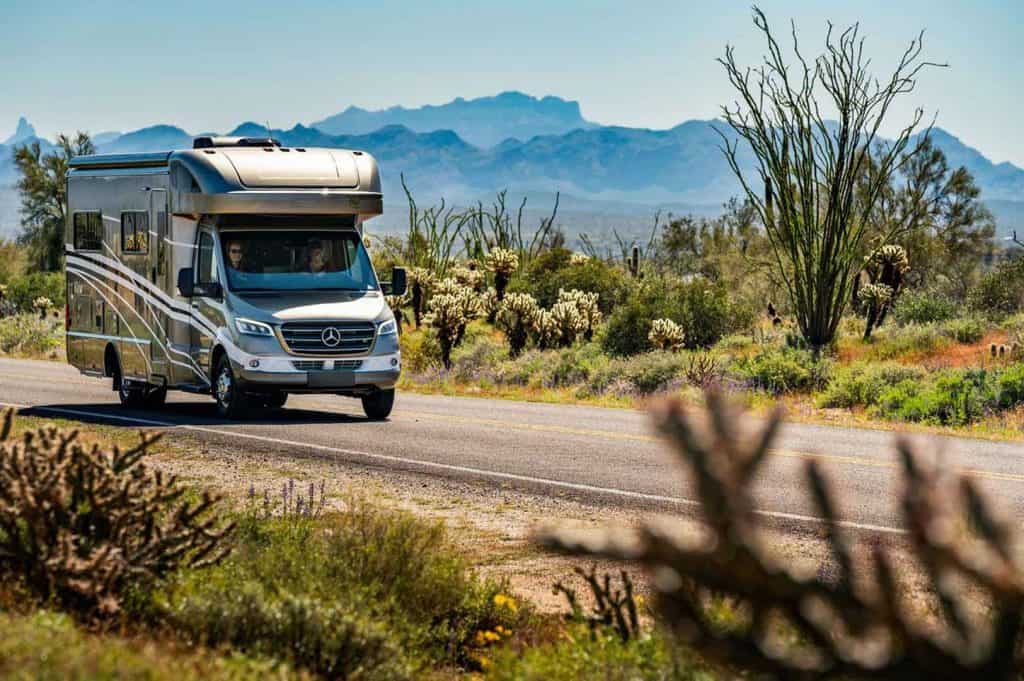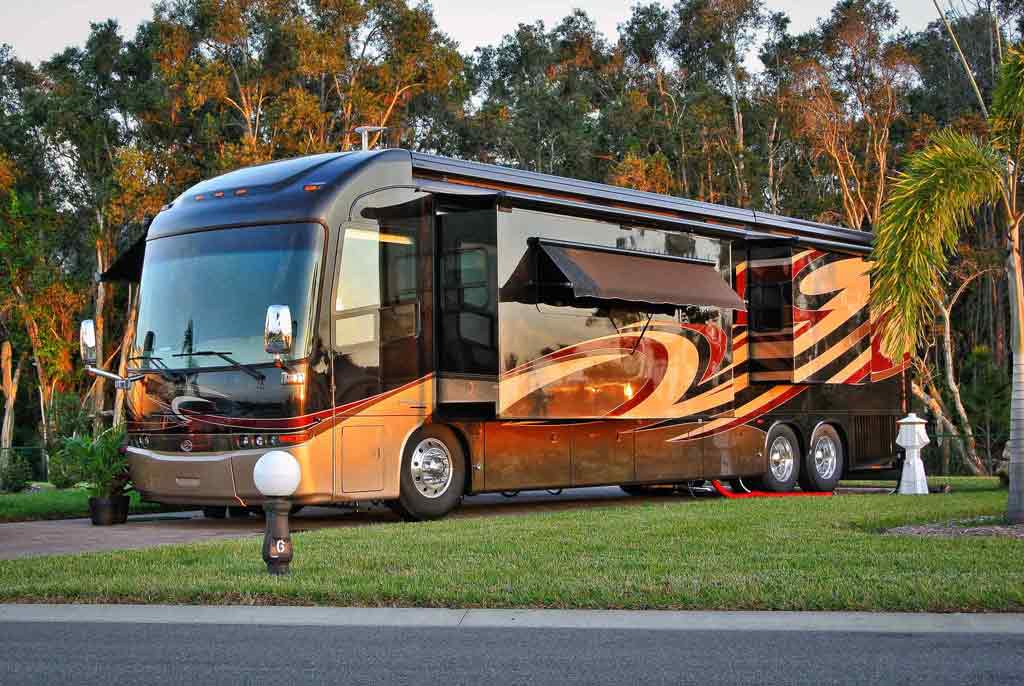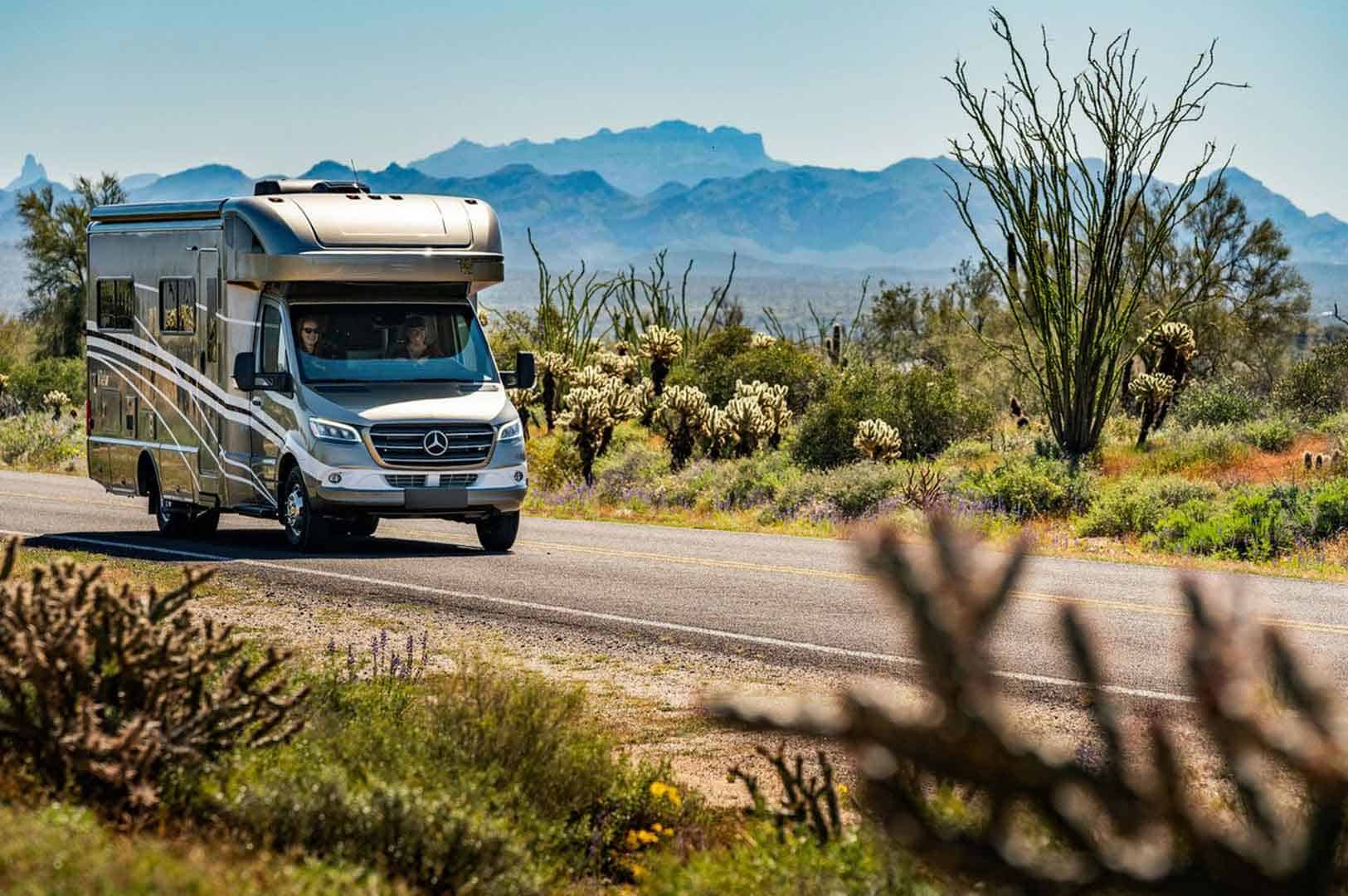The perfect RV doesn’t have to be the most expensive and luxurious ones. It only needs to be the right vehicle for you and your family as fully equipped with the most necessary tools to serve your maximum comfort on every trip.
Excluding class B motorhomes with small sizes that can hardly meet the needs of most long-term family trips, two types of RV, Class C vs Class A would be the more suitable choices for people. It is a common concern of many people before starting to choose a vehicle for individual intentions and purposes to fit each family size.
We can’t be sure which RV class will be the golden face for you to choose to accompany you on long journeys in the future, but we guarantee that you will have some moments scrolling down for valuable and absorbing information right now. Hopefully, when you reach the end of the article, you will find yourself a clear answer! Now let’s discuss about the resemblance and the difference between these 2 popular types of RV with RVing Trends.
Class A vs. Class C: The Similarities
Class A and Class C RV are two typical motorhomes for RV players. They are available in medium to large sizes, suitable for most families with 3 members or a group of 3-4 adults or more. You will not have to squeeze in a small space with many people when a car with a sufficient or spacious size can create too much airy space and help you breathe easier.

We can see that the real purpose of going on a long trip or deciding to live full-time in an RV is always to experience and enjoy time away from busy urban life or spend more quality time with family and friends after a long separation. However, traveling in a cramped car will turn all your original good intentions into smoke. Because then, all you can think about will be: How can my legs stay straight when I sleep tonight? Or should I throw out the wooden table tomorrow to make more room to sleep? Those are thoughts that you shouldn’t have during traveling times, and if you have to live in such a constant state of thinking, you will certainly not be able to enjoy every moment on the road. Therefore, the two types of RVs, class A, and class C are the vehicles that are suitable for the needs of families, couples, or groups of friends who are spending time on vacation.
The second common trait between Class A vs. Class C motorhomes is that both provide basic and necessary amenities such as bedrooms, bathrooms, storage cabinets, fresh/black/grey water tanks, air conditioners, and separate dining areas, regardless of the size.
Not only that, if you don’t want your RV to show up with wet baths, the type of bathroom where the toilet and the place you shower will be in the same place, these two vehicle options will be suitable for your needs as hygienic and airy full-baths design are available.
Both cars can almost perfectly meet the unique requirements of occupants without the need for a vehicle to tow the front or an extra tow vehicle to the rear for added comfort if you feel it is not necessary. Owning a mobile home on wheels with full steering and brakes is convenient and comfortable because you will not have to spend effort and money to maintain and control a vehicle that comes with a frame as bulky as a sedan, SUV, or truck.
Maybe all you need is a separate RV, no matter it’s a class A or a class C, you can still be comfortable on your own and take full advantage of your RV care without spending too much time figuring out how to split the cost to take care of two vehicles equally. It will be an unpleasant experience and make it difficult for you to achieve free-of-mind status on every journey.
These mentioned similarities are something the motorhome class C and motorhome class A share that buyers often consider before taking a car with a large tonnage home. The above two types of vehicles are the most typical and convenient RVs for long-term travel experiences because of the functions they bring, sometimes even exceeding users’ expectations.
Related: The Difference Between Fifth Wheel vs Travel Trailer
Class A vs. Class C RV: The Differences
In addition to the features mentioned above, if you go into the analysis and look more deeply, you will see many notable differences between these two vehicles. Whether you are looking for a low-cost model or a luxury one with full amenities, it is necessary to consider every detail before buying the RV of your dreams to fulfill your needs. Eventually, your needs are always vital, helping you make the most of the money and effort you spend on your ultimate choice of road companion.
RVs in class A vs. class C have different characteristics that you should take into consideration to make the right and reasonable choice from the first time you enter the mobile-auto-home world.
Space
Maybe just based on the category name, you can imagine the two types of vehicles on offer different types of spaces. Depending on your needs and preferences, choose the types of RV that suit your living space for a specified period.
Choosing a cramped RV for trip parties is an unpleasant and distasteful experience. Living space is a crucial factor for any travel. So if the current space can’t make you feel comfortable, it certainly won’t be the RV for you.
In this first round, Motorhome Class A has no rival. The living space of an RV class A will help you have a comfortable travel experience to the last moment without worrying about being restrained or tired due to the secret. The vehicle is built on a bus chassis with a length of 25 to 45 feet and a width of 8 feet. Not only measuring the sleeping space with a large bed, big kitchen, large sofa, and separate dining area, but the spaces used for daily living of the motorhome Class A are super spacious and comfy.

Regarding the class C motorhome, its size is a little smaller than the A, at about 21-40 feet. However, some models can be designed to exceed 39-40 feet. Many RV of this type also have their kitchen and bed, but they will be more compact, or furniture can be disassembled or folded to serve many other purposes. And one great thing about this car is that it has a convenient over cab sleeping area.
However, class C RV will only provide one of two spaces, either a sofa or a dining area. If the original RV has both, the items can be converted to others. For example, a sofa converted into a bed or a sofa area with a folding table for dining. A class C camper can provide the same amount of space as a class A with the slides pulled out, from which the minimum width of this vehicle is from 7 to 8 feet, depending on the available model on the market.
Read more: Best Class A Diesel Motorhomes For The Money
Storage
If the Class A RV has always been considered unbeatable in terms of size, it makes sense that it gives you a great deal of space to store or even stuff things. Not to mention the separate storage space, owning large cabinets and many drawers in the kitchen are enough to help the RV class A prevail in this battle. Class A also has storage areas integrated into the exterior design and the spacious underbody. Some vehicles also have a large basement space that can accommodate a motorbike or ATVs. All will help make your travels more complete and complete because you will not have to try to fit all the necessary furniture into a tiny car anymore.
In contrast, class C, despite having a smaller size, also has available storage spaces such as under-the-bed compartments, drawers, or the cabin on the roof. The motorhome class C also has a small exterior storage space compared to class A.
Fuel Economy
In general, in the fueling battle between Class C vs Class A, Class C will give you more fuel-efficient rides because they are smaller in weight and have lighter engines than class A RV which has a bulky body with fuel consumption of up to 6-7 miles/gallon.
The motorhome Class A has a large and bulky design that can cause many problems with wind resistance. It is also difficult to control, so its engine will also have to spend a lot of power and gasoline in operation to make the car move smoothly without encountering any obstacles on the way. On the other hand, the C-class motorhome has a more streamlined design, so it will face less wind resistance and can operate on the road with a fuel consumption of only about 8-10 miles/gallon.
Amenities
Regarding the amenities provided in both RVs competing with each other from the simplest things, we can see that the amenities that Class A brings to drivers are more brilliant and diverse. Its space is always clear and airy in comparison to the RV Class C, which is somewhat more limited in size and amenities.
Being able to carry a large block on top, the engine of RV class A can equally handle great tools or utilities, such as a large sink or dishwasher, a sometimes queen-size bed, a full refrigerator, electronic devices, and many more. Just simply glancing at its exterior look, you can see that the motorhome Class A is undoubtedly a super-duper convenient mobile home garnished with luxury items and accessories. And for some models, the comfort also comes from the stone table of high-quality materials and sturdy-qualified tile floors.
The Class C RV also has undeniable great amenities and designs. Some of the premium C models on the market can compare to any A-class car. And as usual, to get yourself a good deed, you will have to spend a fair amount, as close as $80,000 to over $200,000, to bring home one dreaming compact SuperPro C.
Drivability
Another difference between class A and class C RV is their drivability. Overall, your time to time experience with an RV is an unreplaceable factor in the pace of choosing what you feel comfortable with when driving. Operating a C-class RV comes to the average driver much more naturally compared to the A-class’s, thanks to the familiar truck-style cabin layout.
Within the RV class C’s driving cabin, the pedals and controls are where you’d expect them to be, and the front wheel is in front of you as you’d normally find in any car or pickup. Class C’s shorter wheelbase also means they have a tighter turning radius, and you’ll have a much easier time operating it at low speeds than you can in the A-class RV.
The first time you drive a Class A motorhome, you may feel very uncomfortable as your sitting place will be much higher than usual as you may not be used to driving such a large vehicle. A class-A RV, nevertheless to say, is an entirely different breed when it comes to driving. Its pedal is placed towards the right side to make room for the steering column as the driver seats are above the front wheel. Moreover, the increased height means that you need to be extra cautious when approaching bridges or overhead hazards. Overall, any first-time rider will feel more comfortable behind the wheel of the motorhome Class C.
Towing
A lot of people may want to tow an SUV, truck, or trailer with the RV to drive around so they will not have to handle a bulky RV once they reach the destination. Adding a trailer or towing vehicles will increase the amount of supervision you have to do, and it adds to the complexity of driving on supposed-to-relax days.
For common sense, many people choose to tow a car when traveling behind A-class RVs , but you can just go and enjoy the scenery with only one C-class RV. This makes driving and traveling on the road much easier and carefree. At the end of the day, unless you’re considering getting a 26-feet vehicle and want to reduce the hassles of driving, your best bet is always a Class C.
Flexibility
When it comes to commuting versatility between Class A vs Class C motorhomes, the C-class shines more than ever. Their shorter length makes them well-suited to many types of RV-traveling purposes. A class C can also make you feel at home when driving through urban streets as well as open roads. In contrast, many U.S. Forest Service National Parks and campgrounds will have length restrictions that may limit Class A owners.
Your preferred camping style is a vital thing to consider. If you like to always stay in private campsites, mostly lounge inside, or travel into city centers, you’ll make the most of Class As’ interior living space. However, if you’re looking for more adventure or want to stay on campsites with a more “in the wild” feel, you’ll have a much easier time in a C-class RV. Boondocking or freestyle camping, which is full of dirt roads and held in public, is also a bit easier in Class C.
The same goes for travel days. It’s harder to get into the RV class A than the class C. The smaller motorhome allows you to easily enjoy a meal as in a restaurant or cafe during a day of travel.
These are by no means impossible for the A-class camper to gain some advantages, but Class C already has an edge due to its smaller size in this round of battle.

Safety
Modern RVs are inherently safe, but several factors can make some RVs safer than others. For example, Class C RVs can sometimes boast more safety features than Class A. Many Class Cs even feature seat belts in the living area, unlike the Class As which rarely have this feature.
In terms of safety equipment, class C comes on top again. Class A drivers sit surprisingly close to the front RV glass, and some of its models rarely have airbags. In contrast, the RV Class C boasts the same airbag protection as the truck they’re based on and features enhanced collision-absorbing contraction zones.
Water Storing Space
If you are planning a long trip or staying in a location without water or drainage, a class A motorhome could be the right choice for your convenience. The space of the A-type not only gives you tons of amenities but also provides plenty of storage for fresh, gray, and black water. With this amount of water tanks, you can comfortably use them for daily activities such as bathing, cleaning, and washing dishes.
The C-class RVs have fewer spaces for tanks containing fresh or wasted water. They are, therefore, more suitable for short-term stays or locations where necessary services are available.
Maintenance
Sadly, the maintenance-free RVs are not available yet. So you should factor maintenance into your RVing routine and budget. If you find yourself having technical RV problems in a small town, you are more likely to find a mechanic who can work on a Class C RV than you can on the complex Class A. You may also find it easy to buy some C-class RV parts to replace if needed.
In the end, the technical-care accessibility of an RV to handle unwanted situations can make a big difference between an enjoyable trip and a ruined one.
Ease At Finding Campgrounds and Parking
Finding campgrounds for class C RVs is much easier as class C is generally shorter and lighter than the other. There are smaller A-class RVs that can smoother the process if you desire. But in general, they are always heavier and demand greater handles.
So if you want a campsite near a river or lake, a Class A can be oversized to sink into the ground and cause many difficulties in daily vehicle management. You may be surprised, but it happens more often than you think. So maybe a Class C RV is better than a Class A RV in this battle round.
You might like: Best Class C RVs For The Money
Price
The last and equally important part of this seemingly never-ending rivalry is the price of each motorhome type. The cost of a new RV is where you’ll find some of the biggest differences between Class A vs Class C.
Class C RVs are usually a bit cheaper, and brand-new models tend to start at around $50,000 in and can go up to $200,000 or even more for the most luxurious models.
A motorhome class A has a price at around $65,000, cost more $15,000 than the C-class. And don’t be too surprised by the million-dollar Class A RV, as all of them have their respective prices that match the comforts they offer within a limited space.
So we’ve gone through a few key factors that help us distinguish the two most-demanded types of RVs. Below will be a summary comparison table of the two types of motorhomes above to help you have a more general view of the strengths and points to consider before taking one of them home.
| Class A Motorhome | Class C Motorhome | |
| Price (average) | $50,000 – $200,000 | $50,000 – $100,000 |
| Size | 25 – 45 feet | 21 – 40 feet |
| Fuel Mileage | 6-7 miles/gallon | 8-10 miles/gallon |
| Water Storage | Fresh/Gray/Black Water | Fresh/Gray/Black Water |
| Maintainance Fee | $500 – $1,000 | $700 – $2,000 |
| Insurance | $1,000 – $1,300 (a year) | $800 – $1000 (a year) |
| Depreciation | Lose ~ 40% retail price (in 3 years) | Lose ~ 25% retail price (in 3 years) |
Class C vs. Class A: Closing
If you are scheduling a plan for long road trips or want to start a refreshed RVing lifestyle, you may first get to the point of choosing a multipurpose vehicle that can turn your seemingly adventurous intention into a dream.
Whether it is the Class C vs. Class A or any other types of RV, we always hope you’ll be able to find a vehicle that will delight, enhance, and captivate your driving experience on every road in town. Turn your trips into great times to capture more memorable moments with your loved ones with your worth-the-wait RV..

